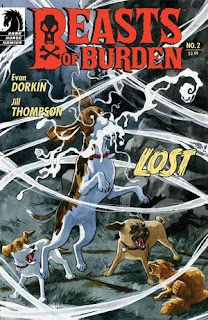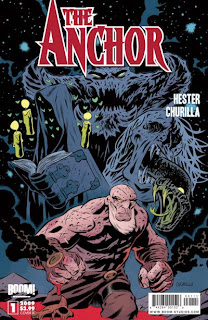Links, lots of links: This gallery of Robert Crumb pictures of women throughout history is nice, although it seems like a collection of separate pieces thrown together, rather than a stuff done as part of a cohesive project. The portraits of girls he went to school with (with notes about what he found attractive about them) seem especially incongruous. Still: it's Crumb, so it's cool.
Everybody else has already linked to this, but I gotta point it out: a new four-page Chris Ware strip for The New Yorker! It's damn good, featuring the one-legged woman from Building Stories, at some point later in her life. Man, I love how he can put together such an affecting and realistic portrait of a human character in such a short space. Good stuff.
On a sillier note, here are some comic strip mashups by Ryan Dunlavey, that plug superheroes or other characters into classic strips like Peanuts or The Family Circus. Funny stuff.
Fundraising notice: Spike, of Templar, Arizona fame, is launching a new book project to be written by her and illustrated by Diana Nock. It's called Poorcraft, and it's all about sharing secrets on living with a low income. Sounds cool, and the neat thing about it is that, as with some other comics projects of late, you can donate to the cause through Kickstarter to help fund the project, and receive neat stuff like autographed copies of the book in exchange. I love that the internet has brought about ideas like this; it's a brave new world.
Finally, Brian Wood has a post on Vertigo's blog listing his favorite historical Viking battles, with notes on how they relate to Northlanders. Cool.
Okay, reviews of single issues, go:
Beasts of Burden #2
Written by Evan Dorkin
Art by Jill Thompson
Wow, this series is surprisingly dark. Although it shouldn't be that much of a surprise; the stories that began the series often dealt with serious issues like death and revenge, but that nature is masked by the cuteness of the protagonists and Jill Thompson's always-gorgeous artwork. But this issue is where we really see what the series is all about; it's not a frivolous fantasy about magic-using doggies and kitties, but an effective device for horror. The story here (involving the ghosts of missing animals and the discovery of what happened to them) really drives it home, with several moments that shock in their violence and don't provide an easy, safe resolution. And the final page is one of the most wrenchingly, hauntingly sad images I've seen in ages; it's going to linger in the memory for a while. Exemplary work from Dorkin and Thompson; this comic is shaping up to be one of the best of the year.
-----
The Order of Dagonet #1
Written by Jeremy Whitley
Art by Jason Strutz
Hey, how crazy would it be if all those entertainers and celebrities that get knighted by the queen of England actually had to defend the crown? That's the premise of this series, and it seems like a fun idea, especially when you throw in the fact that England is being attacked by creatures from the land of faerie and Merlin is the one who gathers them together, apparently giving them magical abilities or some such. It's a fun idea, and while this first issue is mostly devoted to explaining the premise and rounding up the cast, who include stand-ins for Ozzy Osbourne and Neil Gaiman (with a dash of J.K. Rowling), along with a washed up old Shakespearean actor similar to a less-respectable Ian McKellen or Ben Kinglsey, it's interesting enough to warrant attention.
As for the actual execution, it's not perfect, but that's at least partly due to overambition; the issue is full of interesting layouts, like the first couple pages, which see panels appearing as radio waves emanating from a broadcasting antenna:
Unfortunately, the flow can be confusing at times, but it's usually understandable, at least. And the art style itself is idiosyncratic and unique, looking like it was done with crayons or colored pencils and full of little scribbles of color. Again, it's not perfect and can be a bit confusing, but it's interesting just for being different rather than emulating whatever's popular.
If this first issue is any judge, it should be a series to watch, especially once the plot really gets underway. The creators seem to have a real labor of love here, and hopefully they'll continue to improve and make it something really worth reading.
If you're interested, the issue can be purchased from the book's website.
-----
The Anchor #1
Written by Phil Hester
Art by Brian Churilla
Phil Hester might be thought of more as an artist than a writer, but that would be neglecting what is arguably the best work of his career, especially his collaborations with Mike Huddleston, The Coffin and Deep Sleeper. And judging by this issue, The Anchor is another series that should be added to Hester's authorial pedigree. It's one of those action-packed supernatural series, with the hook being that the title character is God's guardian at the gates of Hell, keeping demons from escaping to Earth, while at the same time, he has a physical body on Earth who ends up fighting a giant monster in Iceland in this first issue. It's pretty cool stuff, with some interesting ideas linking the two versions of the character and helping him defeat the monster, and the art by Brian Churilla is really nice, full of ugly demons, expressive characters, and hard-hitting action, and especially making the Anchor looks like a hulking beast of a man, barely intelligent yet massively powerful. It's a nice concept for a comic, and hopefully Hester will continue to build on it and come up with interesting conflicts as the series goes on. In any case, I'm sure Churilla will rise to the occasion and deliver some incredible visuals. Let's make the magic happen, guys!
-----
Robot 13: Colossus #1-2
Written by Thomas Hall
Art by Daniel Bradford
When I first saw preview art for this series, I dismissed it as a Mike Mignola ripoff. Having actually read these first two issues, I'll say that said dismissal might have been hasty, but isn't necessarily unwarranted. The story here, about a mysterious, ancient robot (or whatever it is, consisting of a skull in a fishbowl atop a mechanical body) who, having been found in the depths of the ocean, is constantly fighting gigantic monsters, doesn't really have the depth of Mignola's work, but it's entertaining in its own way, and has its own unique variations on the craggy monsters and deep shadows of Hellboy and the like. Actually, it's fairly light stuff, with nothing much happening outside of those monster fights, aside from a flashback/memory at the beginning of the second issue that suggests the robot originated in ancient Greece. But the fights themselves are quite entertaining, offering some comic value from the spindly-limbed automaton going up against a giant octopus in the first issue and a phoenix in the second. And that phoenix allows for some searingly bright colors and high-altitude combat that does make the series pretty unique. So far, it's not an especially deep comic, but it's a fun one, and one that deserves some attention. Give it a look, if you can find it.
You can purchase the issues here, although the first issue appears to be sold out.
-----
Criminal: The Sinners #1
Written by Ed Brubaker
Art by Sean Phillips
There's not a lot to say about the story of this first issue of the latest Criminal storyline/miniseries, other than it's as good as ever, full of Ed Brubaker's signature character work, propulsive plotting, and utilization of the seedy settings he has created. He's refined this technique to a science by this point, and while he'll probably set up some excellent twists and surprises at some point, right now he's just doing the establishing work that kicks off each new arc, and it's exactly as nicely done as one would expect.
But on the other hand, Sean Phillips can never have too much praise, since his visuals are what really bring this series to life, and while he can be given the same plaudits as Brubaker, in that he's establishing the moody atmosphere and flawed characters in the same manner as normal, there's always something hidden under the surface, some details that really show the care and craft that are put into his work. The years of sin that are etched into this character's face, for example:
Or the variety of easily-read yet understated emotions that are written across this character's visage:
Gorgeous stuff, as always, and something that could certainly warrant a deeper examination. But for now, it's enough for me to note that it's amazing work and a reminder why I love this series so much. Next issue, please.
Bonus: did anybody else note the appearance by 30 Rock's Scott Adsit?
He even got mentioned by name!
-----
Per FTC regulations: some of these reviews were based on complimentary copies provided by the publishers, either electronic or hard copy. But I won't reveal which, lest it damage my precious critical credibility.






















































